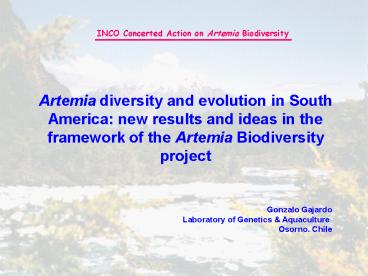Sin t - PowerPoint PPT Presentation
Title:
Sin t
Description:
INCO Concerted Action on Artemia Biodiversity Artemia diversity and evolution in South America: new results and ideas in the framework of the Artemia Biodiversity project – PowerPoint PPT presentation
Number of Views:46
Avg rating:3.0/5.0
Title: Sin t
1
Artemia diversity and evolution in South America
new results and ideas in the framework of the
Artemia Biodiversity project
Gonzalo Gajardo Laboratory of Genetics
Aquaculture Osorno. Chile
2
Thematic partnership
- Artemia adaptation and speciation considering
genetic and environmental factors. - Following aspects are considered relevant i)
standardisation of methodologies (supply cyst
material and published info. For the ARC cyst
Bank and project DataBase) ii) develop regional
or specific collaborations.
Our laboratory gave priority to the
standardisation of protocols to produce genetic
markers for use in speciation and adaptation.
These markers together with other already
considered in our studies are expected to broaden
the evolutionary scenario of Artemia in South
America.
3
- Speciation a multi-disciplinary and
multi-dimensional problem - 1. Geographic distribution, present and past
- 2. Morphology
- 3. Ecology (habitat, food, temperature and
salinity, preferred substrate - 4. Biochemistry and physiology
- 5. Reproductive cycle, chemical and behavioural
isolation mechanisms - 6. Genetics (allozymes, nuclear (n) and mitDNA),
cytogenetics (2n, morphology, karyotype),
immunology, hybridization (natural o artificial)
White 1978
4
What is our current knowledge on Artemia from
Chile?
(1) ecology (physicochemical biological
parameters)
(2) biometry (multivariate discriminant analysis)
(3) reproduction (reproductive performance
isolation)
(4) cytogenetics (chromosomes chromocentres)
(5) electrophoretic studies (allozyme analysis).
5
A glimpse to the Chilean populations
6
(No Transcript)
7
Emphasis on intraspecific genetic change
- Speciation how intra-specific differences turn
out into inter-specific differences
8
A. franciscana
- The best studied species so far
- expanding from an evolutionary viewpoint
- High genetic diversity at coding and non-coding
genomic regions - Great inter-population variation in the satellite
I region amplification of heterochromatin or DNA
content? - Allopatric mode of speciation relevant?
9
Studies at DNA level (exchange 1, Greece)
another approach
Interesting to know is there is congruence at
different levels of the biological organisation
from DNA to phenotypes. Polymorphism at this
level could help
- To extend the knowledge we previously had of
Artemia populations from the New World.
- To clarify if Chilean populations belong to the
species inhabiting the continent, i.e. A.
franciscana or A. persimilis.
- To evaluate the genetic divergence, and
phylogenetic relationships among them as well as
in relation to the other species in the genus.
- Increase tool sensitivity to tackle other
problems - influence of environment in promoting genetic
differentiation, etc.
10
Methodology
First step Training on techniques based in DNA
extraction, amplification by PCR, and
electrophoresis in agarose gels.
Second Standardisation on mtDNA RFLP technique
(9 restriction enzyme ) using 5 Chilean
populations and 2 reference samples.
Third Assessment of genetic divergence and
phylogenetic relationships among populations)
11
Results
- The size of PCR-amplified mtDNA segment (16SRNA)
was c.535 bp.
- Six different haplotypes (composite genotypes)
were found in the populations analysed.
- Fragment patters generated and size (bp) by each
enzyme are showed in Table 1.
12
TABLE 1. Fragment patterns observed among Artemia
populations in part of the 16SRNA region.
Haplotypes in capitals letters and size in
bp. ______________________________________________
__________________
13
Figure 1. Phylogenetic tree based on the presence
or absence of restriction sites.
14
Training/exchange 2
- A 1500 bp mitochondrial rDNA, 12S 16S
15
Results
31 samples including 5 Chilean Artemia samples
and references samples of A. franciscana and A.
persimilis using 8 restriction enzymes (Hae ???,
Mse ?, Hpa ??, Nde ??, Taq ?, Tsp 509 ?, Hinf ?
and Dde ?).
16
31 samples including 7 Chilean Artemia strains
and references samples of A. franciscana, A.
monica, A. persimilis, A. sinica, A. salina, A.
urmiana, A. tibetiana and several parthenogenetic
species using 5 restriction enzymes (Hpa ??, Hae
???, Nde ??, Tsp 509 ? and Taq ?).
17
29 samples including 5 Chilean Artemia strains
and references samples of A. franciscana, A.
monica, A. persimilis, A. sinica, A. salina, A.
monica, A. urmiana, A. tibetiana and several
parthenogenetic strains using 6 restriction
enzymes (Hae ??, Mse ?, Hpa ?, Nde ??, Taq ? and
Tsp 509).
18
(No Transcript)
19
(No Transcript)
20
Artemia work in Chile and adjacent countries a
significant database at different levels
- Morphology
- Karyology
- Allozyme
- Distribution, ecology
- Cross-fertility tests
- Nuclear
- extra-nuclear DNA
21
(No Transcript)

